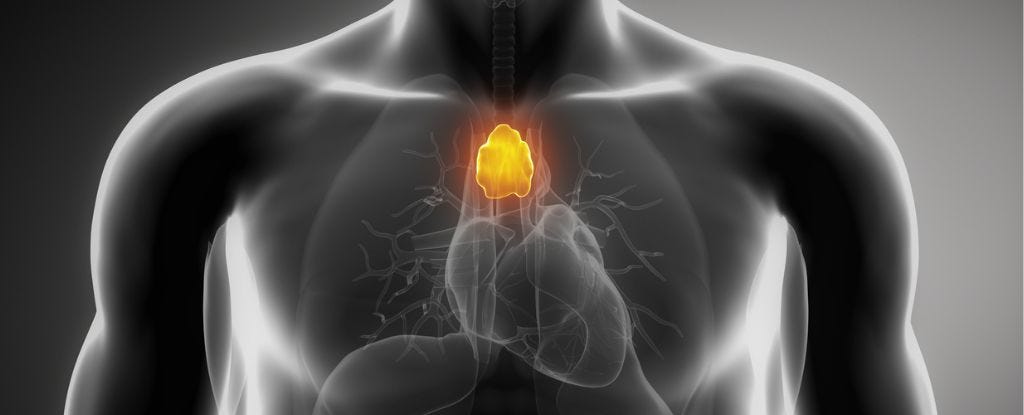Sci-Ed Update 284
Adult thymus isn't useless, why don't humans have fur?, we can't beat AI, AI detectors don't work, body (not brain) controls sleep, racism in healthcare, sharing wisdom w/ students, gut-eye axis, more
'Useless' Organ That Doctors Often Remove May Actually Fight Cancer
There's a small fatty gland that sits behind your sternum and is often said to be 'useless' in adulthood.
A recent retrospective study, however, suggests the thymus gland is not nearly as expendable as experts once thought.
US researchers found that those who get their thymus removed face an increased risk of death from any cause later in life.
They also face an increased risk of developing cancer.
The study is purely observational, which means it cannot show that removing the thymus directly causes cancer or other fatal illnesses.
But researchers are concerned by their findings. Until we know more, they argue that preserving the thymus "should be a clinical priority" where possible.
Read more→ AandP.info/pxn

Luscious fur coats insulate many animals from the cold and protect them from sunlight, insects, and sharp objects in their environments. Yet, somehow humans evolved to be relatively hairless. While this may appear to be a case of selection against a highly desirable trait, Nina Jablonski, who studies the evolution of human skin and skin pigmentation at Pennsylvania State University, said that our relative hairlessness arose just like other traits did: it offered evolutionary advantages.
The origins of human hairlessness began nearly two million years ago, driven by environmental changes in locations where human ancestors lived. As wooded landscapes in equatorial Africa gave way to open grassland areas, human ancestors had to spend more time outdoors to find food and water. For walking and running long distances, early members of the genus Homo developed a modern human skeleton with long legs and shorter arms. “Around this time, humans lost most of their body hair,” said Jablonski.
Read more→ AandP.info/cc56c5
Universities say AI cheats can't be beaten, moving away from attempts to block AI

In submissions to a [Australia] Senate inquiry into the use of generative AI in education, a number now say it is not practical to consider attempting to ban the technologies from use in assessments.
Instead, some such as Monash University in Melbourne say the sector should "decriminalise" AI, and move away from banning it or attempting to detect its use.
"Beyond a desire to encourage responsible experimentation ... an important factor in taking this position is that detection of AI-generated content is unlikely to be feasible," its submission reads.
"Emerging evidence suggests that humans are not reliable in detecting AI-generated content.
"Equally, AI detection tools are non-transparent and unreliable in their testing and reporting of their own accuracy, and are likely to generate an intolerably high proportion of both false positives and false negatives."
Monash submitted that even if regulations were introduced to require AI tools to inject "watermarks" into their code to make AI detectable, other generative AI technologies could still be used to strip out those watermarks.
Instead, it and the nation's other largest universities under the Group of Eight (Go8) umbrella say the sector will have to change how it teaches and assesses students, using more oral or other supervised exams, practical assessments and the use of portfolios.
"Generative AI tools are rapidly evolving and will be part of our collective future – playing an important role in future workplaces and, most likely, our daily lives," tGo8 submitted.
"Entirely prohibiting the use of generative AI in higher education is therefore both impractical and undesirable."
Read more→ AandP.info/shm
International students say AI detectors inaccurate

When Jia Li ran a draft university essay through a computer program used to detect content generated by artificial intelligence, it concluded that just over half was likely machine written.
The program flagged sentences the international student wrote in Chinese and then translated to English using a computer, but also others she wrote in English herself.
"It is my own work but [the program] says it's AI generated," she told the ABC.
Ms Li used the detector because her university has started employing similar tools to flag students who might be cheating by using text-generating AI programs.
"I know other students who were found to have committed misconduct," said Ms Li, who spoke to the ABC on the condition she was able to use a pseudonym.
She is one of a number of international students in Australia who have posted on Chinese social media about concerns tools to detect AI-generated text are unreliable and might lead them to be falsely accused of cheating.
The rapid advent of generative AI programs such as ChatGPT, which are able to produce material such as university essays that some students have been able to pass off as their own work, has universities scrambling to respond.
Some have started using the tools that detect AI-generated text as one way to pick up assignments possibly written by machines.
But AI experts say the technology can be inaccurate, and some argue the detectors should not yet be used to monitor student assessments.
Read more→ AandP.info/cwg
The Body, Not the Brain, Regulates Sleep
Genetic screens have revealed three peripheral tissue genes that regulate sleep. What does this mean for sleep research?
…a new study published in Cell Reports has turned sleep research on its head. Researchers from the University of Tokyo and University of Tsukuba reported three key genes that are critical for regulating sleep—not in the brain, but in peripheral tissues.3 The findings demonstrate that sleep is all about protein homeostasis: endoplasmic reticulum (ER) stress and downregulation of protein biosynthesis in peripheral tissues trigger pathways that induce sleep.
“For a long time, researchers have focused on studying sleep in the brain, but we found that the peripheral tissues are really requesting the brain to sleep,” said Yu Hayashi, a neuroscientist at the University of Tokyo and coauthor of the study. Given that prolonged wakefulness results in longer and deeper sleep, Hayashi hypothesized that there must be sleep-promoting substances that accumulate in the body during the time organisms are awake.
Read more→ AandP.info/eeaa0a
All in A Day’s Work: Give Your “3 Cents” Worth
To support online learners, a former professor at Walden University provided brief essays expanding on instructional topics to demonstrate real-world application and counter common wisdom.

How it worked: Every week, students responded to a prompt related to the presented topic or materials.
In the discussion boards, Mathieu would offer his “three cents” to students—often appropriately priced, he jokes—drawing on his experiences and expertise in the field in short spurts, anywhere from 100 to 500 words.
I would hate to have you go through the course without some of the information I have learned over 35 plus years … so I will be interjecting some of these perspectives when the discussions move in a particular direction that make the information timely,” Mathieu wrote in his first day comments to students.
Kevin Patton comment→ I did pretty much exactly this during my 12 years teaching the Nervous System course in the HAPI program—with similarly good results.
Read more→ AandP.info/4du
Pre-A&P: A Refresher for Student Success in Anatomy & Physiology
In episode 140, we introduce the development of the pre-A&P course and the A&P1 Supplement course. These courses address the challenges faced by A&P students and improve their readiness and comprehension. In this first of two episodes, we focus on the pre-A&P course. It focuses on filling subject knowledge gaps with 10 modules and cumulative tests. Student surveys and studies show its effectiveness in achieving higher grades in the A&P 1 course. Implementing these nontraditional courses requires collaboration and support from advisors and faculty members. Together, we aim to bridge the gap in subject preparation and learning skills for student success.
Kevin Patton comment→ The second part of the two-part series is coming soon. It’s probably a good idea to re-listen to this episode now. Consider it a pre-Pre-A&P refresher exercise!
To listen to this episode, click on the player (if present) or this link→ theAPprofessor.org/podcast-episode-140.html
Racism in health: the roots of the US Black maternal mortality crisis
Reproductive health-care is fraught with racism. In this podcast, we explore how.
A perfect storm of factors has led to huge racial disparities in maternal health care. In the United States, as abortion clinics continue to close, this inequity is projected to widen. In this podcast from Nature and Scientific American, we hear from leading academics unpacking the racism at the heart of the system. From the historical links between slavery and gynaecology to the systematic erasure of America’s Black midwives. What is behind the Black maternal mortality crisis, and what needs to change?
Read more→ AandP.info/9jp
Mysterious Form of Vision Loss May Brew Inside The Gut, Scientists Say
In some glaucoma patients, vision loss mysteriously progresses despite treatment, and new research from China points to immune cells that migrate from the digestive tract to the eyes.
These "gut-retina axis" cells bind a specific protein and gain access to the eye's light-sensitive tissue, where they damage retinal ganglion cells (RGCs).
Glaucoma, classified as a group of neurodegenerative diseases, is an umbrella term for eye diseases caused by loss of RGCs, whose axons form the optic nerve which transmits visual information to the brain.
Your optic nerve is sending this to your brain's visual cortex to process right now, if you're reading with your eyes.
A leading cause of blindness, glaucoma is currently incurable; treatment aims to halt disease progression.
"Our findings emphasize the importance of the gut-retina axis in glaucoma pathogenesis and for the development of therapeutic strategies," the researchers write in their paper.
Read more→ AandP.info/gqj






